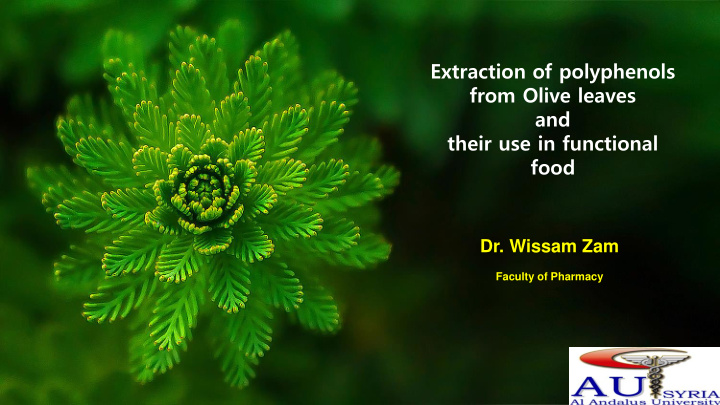



Extraction of polyphenols from Olive leaves and their use in functional food Dr. Wissam Zam Faculty of Pharmacy
Functional foods
5/10 of deaths due to chronic diseases are caused by unhealthy diets Cardiovascular Type II Some Stroke disease diabetes cancers Saturated Refines and trans Sodium Cholesterol sugars fatty acids
Functional foods
Functional foods vs Dietary supplements
اهفينصت قفو American Dietetic Association Conventional foods Foods for special Modified foods dietary use Medical foods
Common functional food Probiotics & Prebiotics omega-3 Antioxidants Common functional food Phytosterols Vitamins and and some minerals phospholipids
Olive leaves
Oleaceae Olea europaea L.
Why? Bioactive compounds Most abundant Polyphenol (antioxidant) Oleuropein 20% Diabetes Hypertension In food as an antioxidant Bone health Anti-cancer effect
Why Olive leaf extract (OLE) contains a higher quantity and variety of polyphenols than those found in olive oil The good absorption of its phenolic constituents Their good bioavailability
Study design
Problematic
Results Ethanol of 40% 60 °C 120 min
Ionotropic gelation 53.80±2.59%
In-vitro release study 120 In-vitro release in intestinal In-vitro release in gastric medium 100 Polyphenol release 80 60 40 % 20 0 0 30 60 120 180 240 Time Time Time Time
Publications 1. Zam Wissam, Ali Ali, Hasan Rama. Optimization of extraction conditions for the recovery of phenolic compounds and antioxidants from Syrian olive leaves. Journal of Pharmacognosy an d Phytochemistry. 2016;5(5):390-394. 2. Zam Wissam, Ali Ali. Olive leaves herbal tea effect in type 2 diabetic patients with prehypertension. European Journal of Pharmaceutical and Medical Research. 2017; 4(5), 55-59. 3. Zam Wissam, Ali Ali, Hasan Rama. Influence of different parameters on the preparation of oliv e leaves extract beads. Journal of Chemical and Pharmaceutical Science 2018;11(1):87-92.
Thank you for your attention
Recommend
More recommend